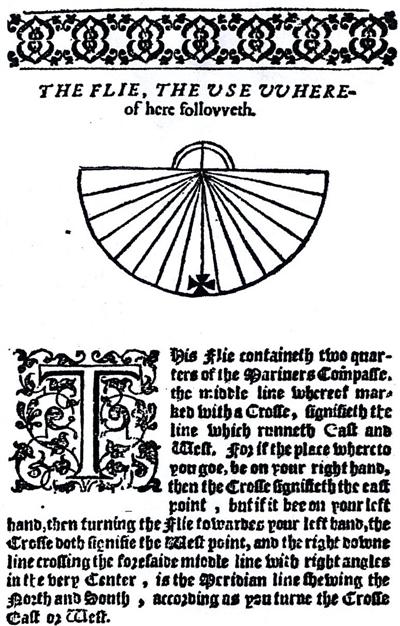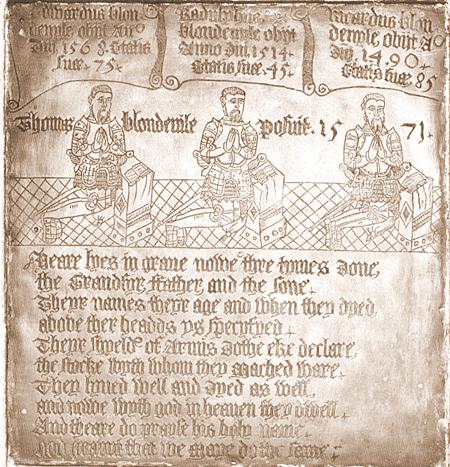| Thomas
Blundeville (c.1522 – c.1606)
was an English humanist writer and mathematician. He is known for work on logic,
astronomy, education and horsemanship, as well as for translations from the
Italian. His interests were both wide-ranging and directed towards practical
ends, and he adapted freely a number of the works he translated. He was a pioneer writer in English in several areas, and inventor of, what would become, a standard classroom geometrical instrument, the protractor.
LifeThomas Blundeville was born around 1522 in Newton Flotman, Norfolk. He was one of four sons born to Edward Blundeville by his first wife Elizabeth (daughter of Sir Thomas Godsalve and Lord of Inglos Manor in Loddon). He also had a sister Constance who later married William Burnell. In the "postscript" to his "Arte of Logicke" Thomas says:
Thomas also had two half brothers, Jerome and John, from his father's later marriage to Barbara Drake. It is from Jerome that most of the Blunderfields listed in this family tree are descended. The authors of 'Athenie Cantabrigienses' suppose that Thomas Blundeville was educated at Cambridge, though they are unable to specify the period, the college or house to which he belonged. It is known that he was resident at Cambridge about the same time as John Dee (who became an advisor to Elizabeth I) and the astronomer Thomas Digges, possibly as a non-collegiate student, and if so must have been one of the last of them. It seems probable that he travelled to Italy, an inference from his familiarity with Italian literature. He was a mathematics tutor to Elizabeth Bacon, the daughter of Sir Nicholas Bacon (politician and lawyer) and to Sir Francis Wyndham. The arithmetic exercises that he prepared for Elizabeth Bacon, formed the basis of his best selling work The Exercises which he first published in 1594 and went through seven editions. He had connections with court circles, and London scientific intellectuals. He was an associate of Henry Briggs, Professor of Geometry at Gresham College, and enjoyed the patronage of Robert Dudley, 1st Earl of Leicester, among other aristocrats. He married twice; firstly to Rose Putenham in 1554 by whom he had a son and heir Andrew1. Sadly Andrew was killed in the Flemish wars. Rose died during a visit, with Thomas, to his sister Constance at Winkborne in Nottinghamshire - she was buried there on 24th October 1564. Secondly, he married Margaret Johnson in 1582 by whom he had two daughters, Elizabeth and Patience. Daughter Elizabeth married Rowland Meyrick, son of Sir Gelli Meyrick who was steward to Robert Devereux, 2nd Earl of Essex and caught up in his fall. Patience married Robert King, of Culpho in Suffolk. Thomas Inherited the Manor of Newton Flotman in 1568 when his father Edward died. He lived as a country gentleman and seems to have managed the estate prudently. Thomas erected the Blundeville family tomb, under which he lies buried; in the church of Newton Flotman. The monument is a fascinating illustration of the sort of man he was. In the centre panel he kneels bare-headed, in armour, his helmet and a book on the prayer desk beside him, while to the left, his two wives Rose and Margaret kneel, dressed in gowns with big ruffs and Tudor bonnets, along with his daughters Patience and Elizabeth.
In the right hand panel is a London made brass with effigies of his great-grandfather Richard, grandfather Ralph and father Edward, with their ages and the dates of their deaths. The inscription by the figures records that Thomas placed it here in 1571.
The text of this brass reads as follows:
The London Subsidy Returns of 1576, list Thomas Blundevile as being worth 20 pounds. Thomas died in 1605, with no male issue, leaving his two daughters as co-heiresses. The Manor of Newton Flotman, which had continued in the Blundeville family for more than 5 centuries, was sold in 1646 by Robert King, the husband of Thomas's youngest daughter Patience who died in 1538. Notes |
WritingsEarly Works
His book on horsemanship The Art of Riding (c.1560) was the first work on equitation published in English. It was an adaptation of a work by Federico Grisone and was directed towards the use of horses in war. He followed it with The Fower chiefyst offices belongyng to horsemanshippe (1565–6) and is dedicated to Robert Dudley, Earl of Leicester........
It was praised as "Xenophontean" by the 16th century English writer Gabriel Harvey. A very briefe and profitable Treatise, declaring howe many Counsels and what manner of Counselers a Prince that will governe well ought to have. The treatise was written originally in Spanish by Federigo Furio Ceriól, translated thence into Italian by Alfonso d'Woa, and from Italian into English bv Blundeville. There is a dedication, dated from Newton Flotman 1st April 1570, to the Earl of Leicester. His True Order and Methode (1574) was dedicated to the Earl of Leicester and was a loose translation and summary of historiographical works by the Italian philosophers Jacopo Aconcio and Francesco Patrizzi. It endorsed the realist writing of history as process, and was one of the few English contributions of the period to the artes historicae. He translated also a manuscript of Aconcio on fortification, for the Earl of Bedford. His Arte of Logike (written in 1575, published in 1599)......
It contains a section on fallacies and examples of Aristotelian and Copernican arguments on the motion of the Earth. Later
Works The Exercises (1594) initially collected six treatises on practical skills, with a serious effort to be up-to-date. One of the parts described the world map of Petrus Plancius, published just two years earlier. Other topical matters covered were Molyneux's globes, the work of John Blagrave (Mathematician) and Gemma Frisius (Cartographer), and the Thomas Hood Cross-Staff (used for measuring the angle of the sun above the horizon)
A later edition (1613) showed the circumnavigations of Francis Drake and Thomas Cavendish. Two more Treatises must have been added, as the 1622 edition was entitled M. Blundevile His Exercises, Contayning eight Treatises.....
An original 1st Edition of 'His Exercises' was sold by Christie's in 2007 for $20,400. The work was very popular and went through seven editions before 1636. He collaborated on an astronomy book, The Theoriques of the Seven Planets (1602), assisted by Lancelot Browne, the queen's physician. It contained information about the recent research of Dr William Gilbert on the Earth's magnetic field, together with the making of two instruments for seamen to find out the latitude without seeing sun, moon, or stars.
In his Briefe Description of Universal Mappes and Cardes. Thomas had worked with William Barlow (magenetism and particularly compasses at sea) and others on the required scientific instruments and has been credited with the invention of the protractor - he described a semicircular instrument for measuring angles. |


